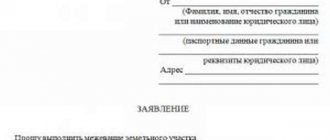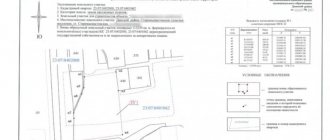On what basis does the state seize land?
In addition to scheduled and unscheduled inspections, on the basis of No. 234-FZ dated July 2, 2014, within the framework of land control, a form for detecting and recording an offense has been created - an administrative inspection of land relations objects. Unlike scheduled and unscheduled inspections, administrative inspections do not require compliance with a special appointment procedure. As stated in the law, an administrative survey is carried out as part of systematic monitoring of compliance with the requirements of the legislation of the Russian Federation.
In other words, the inspector has the right to begin an administrative inspection of your land plot at any time, and the frequency of such inspections is not limited.
At the same time, the administrative inspection should not interfere with the economic activities of the owner. When studying the condition of a land plot, aerospace photography, the results of soil, agrochemical, phytosanitary, environmental and toxicological examinations and other methods are used.
If violations of land legislation are identified as a result of an administrative survey, the results of such a survey are documented in an act. Identification of offenses is the basis for ordering a full-fledged unscheduled inspection against the owner with possible subsequent confiscation of the land plot.
Reasons for an unscheduled inspection of a land plot by an inspector
During the administrative survey, the inspector may discover land violations such as:
- use of a land plot not for its intended purpose in accordance with its category of land and type of permitted use;
- non-use of agricultural land, the turnover of which is regulated by No. 101-FZ dated July 24, 2002, for its intended purpose within one year from the moment ownership rights arise;
- non-use of a land plot intended for housing or other construction, gardening, vegetable gardening, for the specified rental purposes.
What threatens a careless owner?
In accordance with Art. 8.8 of the Code of Administrative Offenses of the Russian Federation, failure to fulfill or untimely fulfillment of duties to bring land into a state suitable for use for its intended purpose, including the imposition of an administrative fine on citizens in the amount of 20,000 to 50,000 rubles; for officials - from 100,000 to 200,000 rubles; for legal entities – from 200,000 to 400,000 rubles.
Failure to comply with the instructions of Rosselkhoznadzor is also punishable and entails a fine.
Furthermore, in accordance with Art. 6 of the Federal Law of July 24, 2002 No. 101-FZ “On the turnover of agricultural lands”, a land plot from agricultural lands can be forcibly seized from its owner in court if, for 3 or more consecutive years from the date of identification within the framework of state land supervision, the fact of non-use of a land plot for its intended purpose or use in violation of the legislation of the Russian Federation.
Thus, agricultural lands under the conditions of forced termination of the right of permanent perpetual use, the right of lifelong inheritable possession, the right of gratuitous fixed-term use, as well as the seizure of such land plots from the owner in court will be put up for sale at public auction, or acquired by the state or municipal property.
At the same time, the effect of Federal Law No. 101 does not apply to garden and vegetable plots related to agricultural lands, land plots intended for personal farming, garage construction, and land plots on which real estate objects are located. The turnover of these land plots is regulated by the Land Code of the Russian Federation.
What is the fine for misuse of land?
Clause 2 of Art. No. 7 of the Land Code of the Russian Federation stipulates that lands must be used in accordance with the intended purpose and zoning of the territories established for them. For example, if the owner of a land plot builds a residential building without changing the permitted use for individual housing construction, then he will have an administrative offense in accordance with paragraph 1 of Article 8.8 of the Code of Administrative Offenses of the Russian Federation.
Use of a land plot for purposes other than its intended purpose shall entail the imposition of an administrative fine. For legal entities, the fine is 1.5-2% of the cadastral value of the entire land plot, but not less than 100 thousand rubles. For individuals in the amount of 0.5-1% of the cadastral value of the plot.
The size of the plot is larger than in the documents, or there are no documents at all
In both cases, the same result is an accusation of unauthorized seizure of land. This problem is often faced by those who neglected land surveying. If the boundaries of the plot diverge from the data of the public cadastral map, then problems await the owner.
If the title documents were received a long time ago and have not been preserved, in some cases it will simply be impossible to prove ownership of the land.
An order will be issued to release the illegally seized land. In addition, in accordance with Article 7.1 of the Code of Administrative Offenses, a citizen will have to pay a fine in the amount of 1% to 1.5% of the cadastral value of illegally occupied land, and if such has not been determined - from 5,000 to 10,000 rubles.
Reasons for seizure of agricultural land
According to Article No. 6 of the Land Code of the Russian Federation “Forcible withdrawal and termination of rights to land plots from agricultural lands,” two grounds are provided for the withdrawal of agricultural lands.
Deterioration of useful properties of land
A plot of agricultural land can be forcibly seized from its owner in court if the land plot is used in violation of the requirements for the rational use of land, resulting in a significant decrease in fertility or a significant deterioration of the environmental situation. The criteria for a significant decrease in fertility are established by Decree of the Government of the Russian Federation No. 612 of July 22, 2011, and the criteria for a significant deterioration of the environmental situation are established by Decree of the Government of the Russian Federation No. 736 of July 19, 2012.
A significant decrease in the fertility of agricultural land is a change in the numerical values of at least 3 of the following criteria:
- a decrease in the content of organic matter in the arable horizon by 15 percent or more;
- reducing acidity in acidic soils by 10 percent or more;
- increasing alkalinity in alkaline soils by 10 percent or more;
- reduction in available phosphorus (mg/kg soil) by 25 percent or more;
- reduction in exchangeable potassium content (mg/kg soil) by 25 percent or more.
The criteria for significant deterioration of the environmental situation as a result of the use of agricultural land in violation of the requirements for rational use of land are:
- soil contamination with chemicals, in which the total content of pollutants in the soil, the concentration of which exceeds the maximum permissible concentration standards established for chemicals, is equal to or exceeds 30;
- placement of production and consumption waste of hazard classes 1-4 within a land plot on a total area of 0.5 hectares and above.
The land plot has not been used for more than 3 years
A land plot from agricultural lands can be forcibly seized from its owner in court if, for three or more consecutive years from the date the owner acquired the right of ownership of the land plot, it is not used for agricultural production or other related activities. agricultural production and activities. The 3-year period does not include the period during which the land plot could not be used for its intended purpose due to natural disasters or other circumstances precluding such use, as well as the period for development of the land plot. The period for land development cannot be more than two years.
Signs of non-use of land plots, taking into account the specifics of agricultural production or other activities related to agricultural production, are established in Decree of the Government of the Russian Federation No. 369 of April 23, 2012.
Signs of non-use of agricultural land
The federal law of July 24, 2002 No. 101-FZ “On the turnover of agricultural lands” was called upon to regulate relations related to the ownership, use, and disposal of land plots from agricultural lands.
As a result of the ongoing unfair use of agricultural land, Decree of the Government of the Russian Federation dated April 23, 2012 No. 369 established a List of signs of non-use of land plots for agricultural production or other activities related to agricultural production, namely:
Non-use of a land plot is determined based on one of the following criteria:
- no work on cultivating crops or cultivating the soil is carried out on the arable land;
- There is no haymaking on the hayfields;
- on cultivated hayfields, the content of weeds in the structure of the grass stand exceeds 30 percent of the area of the land plot;
- there is no grazing of livestock on pastures;
- on perennial plantings, maintenance and harvesting of perennial plantings is not carried out and decommissioned perennial plantings are not uprooted;
- forest and (or) bush cover on arable land exceeds 15 percent of the land area;
- forest cover and (or) bush cover on other types of agricultural land is over 30 percent;
- Tussocks and (or) waterlogging account for over 20 percent of the land area.
State land supervision on agricultural lands, within its competence, is carried out by Rosselkhoznadzor, conducting it in the form of on-site scheduled and unscheduled inspections.
Cases of unscheduled inspections by Rosselkhoznadzor based on statements from citizens and organizations about non-use of land by owners are becoming more frequent.
As a result of identified violations by Rosselkhoznadzor officials, land owners and tenants are issued an order on compliance with the requirements of land legislation and elimination of identified violations in the field of land relations.

Reasons for seizure of land for construction
- Based on Article 284 of the Civil Code of the Russian Federation, failure to use a land plot for construction within 3 years gives the lessor the right to demand termination of the lease agreement.
- In addition, a land plot can be seized from the owner in cases where the plot is intended for construction and is not used for the corresponding purpose for three years, unless a longer period is established by law. This fact can be easily established by looking at satellite images of the area, or you can discover this fact when visiting the area.
Failure to use a land plot for construction purposes within the time limits established by law not only entails administrative liability under Article 8.8 of the Code of Administrative Offenses of the Russian Federation, but also entails serious risks of loss of the right to a land plot.
How does the seizure of land for municipal needs occur?
- According to Article 54 of the Land Code of the Russian Federation and subparagraph 1 of paragraph 2 of Article 45 of the Land Code of the Russian Federation, the seizure of a land plot in connection with its improper use is carried out after the entry into force of the decision on administrative punishment in the form of an administrative fine imposed for the offense and provided that the violation has not been eliminated .
- Simultaneously with the imposition of an administrative penalty, the federal executive body exercising state land supervision issues an order to eliminate the committed land offense, containing a period during which the land offense must be eliminated, to the person guilty of violating land legislation.
- If the owner of the land plot has not eliminated the violation within the prescribed period, the executive body sends copies of the materials of state land supervision to the authorized government body of the subject of the federation or local government body, which sends an application to the court for the seizure of the land plot.
Where can I complain about misuse of land?
How is the fact of misuse of a land plot established? The land is especially controlled by the state. Compliance with the terms of the law regarding the use of the site, as well as clarification of the location of the boundaries of the land plot, is subject to careful monitoring by a special committee, which can be served by the local administration together with the Rosreestr department.
The fact of misuse of a land plot can begin to be established:
- If the application is written by neighbors or the chairman of a gardening non-profit partnership.
- When checking government officials.
- When establishing the fact of misuse of a land plot, the territory can be visually identified as unused.
If the land plot is not used for its intended purpose, then it is possible to focus on their ownerlessness, seeking recognition of this status through a court hearing (you can find out more about other legal disputes with land at the link - consideration of land disputes with our lawyer). After which the procedure for using the land is simplified for you.
USEFUL: watch the video with additional tips on filing a complaint by authority
How can a land plot under construction be seized?
In accordance with No. 171-FZ dated June 23, 2014, for owners of unfinished construction projects, there are risks of losing ownership of these objects.
If the construction of a real estate property on a leased plot is not completed before the expiration of the lease term, then the owner of the unfinished construction facility has the right to purchase the plot for rent for a new term, but not more than 3 years, without bidding. However, this right can be exercised only if, within 6 months from the date of expiration of the lease agreement, the authorized body does not file a claim with the court to seize the unfinished construction project. The requirement cannot be satisfied only if the violation of the construction deadline is associated with the actions (inaction) of government bodies (local government) or persons operating utility networks.
In other cases, the court may decide to sell the unfinished construction project at public auction. The initial sale price of an unfinished construction project is determined based on an assessment of its market value.
The proceeds from the sale of the unfinished property are paid to the former owner of the property minus the costs of preparing and holding public auctions.








